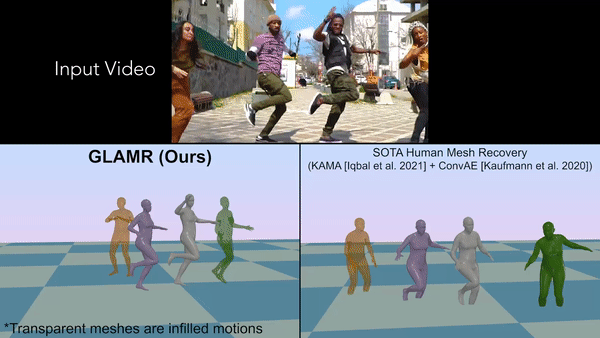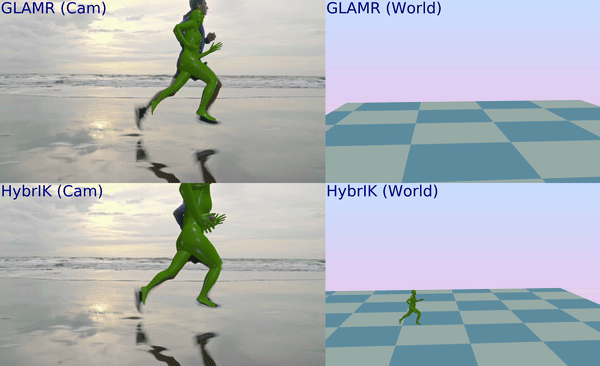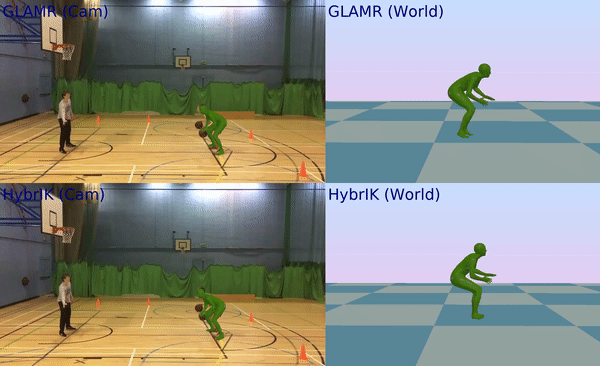GLAMR
This repo contains the official PyTorch implementation of our paper:
GLAMR: Global Occlusion-Aware Human Mesh Recovery with Dynamic Cameras
Ye Yuan, Umar Iqbal, Pavlo Molchanov, Kris Kitani, Jan Kautz
CVPR 2022 (Oral)
website | paper | video
Overview
News
- [08/01/22]: Demos for dynamic and static videos are released!
Table of Content
- Installation
- Demo
- Datasets
- Motion Infiller
- Trajectory Predictor
- Joint Motion Infiller and Trajectory Predictor
- Citation
Installation
Environment
- Tested OS: MacOS, Linux
- Python >= 3.7
- PyTorch >= 1.8.0
- HybrIK (used in demo)
Dependencies
- Clone this repo recursively:
This will fetch the submodule HybrIK.
git clone --recursive https://github.com/NVlabs/GLAMR.git - Follow HybrIK's installation instructions and download its models.
- Install PyTorch 1.8.0 with the correct CUDA version.
- Install system dependencies (Linux only):
source install.sh - Install python dependencies:
pip install -r requirements.txt - Download SMPL models & joint regressors and place them in the
datafolder. You can obtain the model following SPEC's instructions here.
Pretrained Models
- You can download third-party pretrained models from Google Drive or BaiduYun.
- Once the
glamr_models.zipfile is downloaded, unzipping it will create theresultsfolder:Note that the pretrained models directly correspond to the config files for the motion infiller and trajectory predictor.unzip glamr_models.zip
Demo
We provide demos for single-person video with both dynamic and static cameras.
Dynamic Videos
Run the following command to test GLAMR on a single-person video with dynamic camera:
python global_recon/run_demo.py --cfg glamr_dynamic \
--video_path assets/dynamic/running.mp4 \
--out_dir out/glamr_dynamic/running \
--save_video
This will output results to out/glamr_dynamic/running. Results videos will be saved to out/glamr_dynamic/running/grecon_videos. Additional dynamic test videos can be found in assets/dynamic. More video comparison with HybrIK are available here.
Static Videos
Run the following command to test GLAMR on a single-person video with static camera:
python global_recon/run_demo.py --cfg glamr_static \
--video_path assets/static/basketball.mp4 \
--out_dir out/glamr_static/basketball \
--save_video
This will output results to out/glamr_dynamic/basketball. Results videos will be saved to out/glamr_dynamic/basketball/grecon_videos. Additional static test videos can be found in assets/static. More video comparison with HybrIK are available here.
Datasets
We use three datasets: AMASS, 3DPW, and Dynamic Human3.6M. Please download them from the official website and place them in the dataset folder with the following structure:
${GLAMR_ROOT}
|-- datasets
| |-- 3DPW
| |-- amass
| |-- H36M
AMASS
The following command processes the original AMASS dataset into a processed version used in the code:
python preprocess/preprocess_amass.py
3DPW
The following command processes the original 3DPW dataset into a processed version used in the code:
python preprocess/preprocess_3dpw.py
Dynamic Human3.6M
Please refer to this doc for generating the Dynamic Human3.6M dataset.
Motion Infiller
To train the motion infiller:
python motion_infiller/train.py --cfg motion_infiller_demo --ngpus 1
where we use the config motion_infiller_demo.
To visualize the trained motion infiller on test data:
python motion_infiller/vis_motion_infiller.py --cfg motion_infiller_demo --num_seq 5
where num_seq is the number of sequences to visualize. This command will save results videos to out/vis_motion_infiller.
Trajectory Predictor
To train the trajectory predictor:
python traj_pred/train.py --cfg traj_pred_demo --ngpus 1
where we use the config traj_pred_demo.
To visualize the trained trajectory predictor on test data:
python traj_pred/vis_traj_pred.py --cfg traj_pred_demo --num_seq 5
where num_seq is the number of sequences to visualize. This command will save results videos to out/vis_traj_pred.
Joint Motion Infiller and Trajectory Predictor
For ease of use, we also define a joint (wrapper) model of motion infiller and trajectory predictor, i.e., the model merges the motion infilling and trajectory prediction stages. The joint model composes of pretrained motion infiller and trajectory predictor and is just a convenient abstraction. We can define the joint model using config files such as joint_motion_traj_demo. The joint model will also be used in the global optimization stage.
To visualize the joint model's results:
python motion_infiller/vis_motion_traj_joint_model.py --cfg joint_motion_traj_demo --num_seq 5
where num_seq is the number of sequences to visualize. This command will save results videos to out/vis_motion_traj_joint_model.
Citation
If you find our work useful in your research, please cite our paper GLAMR:
@inproceedings{yuan2022glamr,
title={GLAMR: Global Occlusion-Aware Human Mesh Recovery with Dynamic Cameras},
author={Yuan, Ye and Iqbal, Umar and Molchanov, Pavlo and Kitani, Kris and Kautz, Jan},
booktitle={Proceedings of the IEEE/CVF Conference on Computer Vision and Pattern Recognition (CVPR)},
year={2022}
}License
Please see the license for further details.



